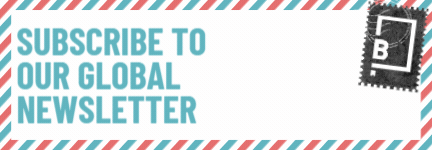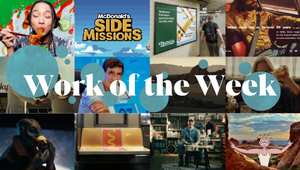
The Work That Made Me: JD Smyth

JD Smyth has worked as an editor for 20 years, with over a decade at Final Cut. The span of work he’s edited has been honored with Emmys, Cannes Lions, and One Show Pencils. He has cut highly-lauded work for GE, the NFL, AT&T & HBO; longer-form content for Unilever, GQ and Sandy Hook Promise; and music videos for Beyonce, Radiohead and Justin Timberlake. His first feature film, Stray Dolls, premiered at the 2019 Tribeca Film Festival.
The ad/music video from my childhood that stays with me…
Coming of age around the advent of MTV, music videos were a big deal. I was a Michael Jackson fan. Before he went full Teddy Perkins, there was 'Thriller', a music video so far ahead of its time in what music videos could be, giving permission for them to be mini-movies - opening credits, breaking the music track - that affected everything to come while the industry was still in its infancy. I had a VHS of it, bought from WHSmith, and as well as the full-length version of the video, which had a making-of documentary that really solidified a fascination with ‘behind-the-scenes’ content (harder to come by in the pre-YouTube/Vimeo era).
A bit later, it was Tim Pope’s videos for the Cure. 'Close To Me' and 'Lullaby' in particular. While everyone else (except Micheal) was doing performance videos with a visual hook, they were creating these surreal three-minute fairy-tale nightmare-fever-dreams.
The ad/music video/game/web platform that made me want to get into the industry…
My best friend's father was an art director on movies, and one morning he took us to the set of The Empire Strikes Back. The millennium falcon wasn’t painted yet, revealing the fact that it was made of wood, and you couldn’t walk up that iconic ramp into it because the interiors were on another stage. We visited the Rebel Hoth base, Cloud City, and the swampland of Dagobah and saw all the props, including Han Solo in Carbonite. Like many kids of that age, I was obsessed with Star Wars, and from that day, I knew I wanted to somehow be involved in the 'the business'.
That and 'The French Connection', which my mum allowed me to watch, staying up late one night. The gritty New York hand-held aesthetic was in direct contrast to anything Star Wars, but still felt a million miles away from North London, and the ambiguity of the ending blew me away.
The creative work (film/album/game/ad/album/book/poem etc) that I keep revisiting…
I got my start working at Ridley Scott Associates in London, and I was always really inspired by Adrian Moat. He’s a really soulful director who always approaches his work in truly interesting ways.
He did a spot for the NHS where he had to film a child non-actor in his home environment. Adrian used a mini crane-arm set up so that he could choose his shots quickly and decisively without having to do multiple resets, allowing the boy just to be himself and the crew to stay out of his way. I thought that was brilliant, but I then saw the call sheet for the next day’s shoot, and there was no camera package! They went to a hospital and just shot sound, with lots of different microphones instead of different camera lens lengths. So wides of waiting room ambiance and close-ups of defibrillators, etc. The way he combined those separate visual and audio elements in the final edit was a huge inspiration for me and still is.
Also Guinness ‘Swim Black’ by Jonathan Glazer. Everyone calls out the 'Swimmers' spot for good reason, but the thing I love about “Swim Black” is that it’s a perfectly told story that brilliantly illustrates the tagline. It’s cinematic and funny and emotional, and it could be set anywhere, from a fishing port in Ireland to the Côte d'Ivoire.
My first professional project…
RSA had decided to buy an Avid for directors to tinker around on, and I became its caretaker. I did mood films for directors and assisted directors who cut their own projects. Babak Zand Goodarzi was an up-and-coming director there and let me re-edit a music video he’d already delivered to prove myself, and on the basis of that, he let me cut the music video for “Les Nuits” by Nightmares On Wax. In those days, to conserve data space, the avid stripped away the second field in the footage. Babak shot it on hi-8 video; we turned it black and white, and with the field stripped out, it gave it a very cinematic look, or so we thought back then. Adrian Harrison, RSA’s managing director at the time, insisted that we never tell anybody the truth about what we shot it on – we thought it looked like 16mm! That was the first of a few times, including assisting Chris Cunningham on Squarepusher and Aphex Twin and cutting “Papercuts” by Broadcast for Babak, that I got to work with Steve and Rob from Warp records – true visionaries, courageous, and absolute gentleman. I was very spoilt for my first client experience.
The piece of work (ad/music video/ platform…) that still makes me jealous…
Probably Jake Scott’s Nike “Move” commercial. It’s an impeccably crafted piece of work that prompted 20 years' worth of match-cut commercials, of which I’ve done a fair few, but none have really bested its form and function.
More recently, Final Cut’s Matt Carter edited a video for Nas’s track “Ugly.” I think he had one setup of a Nas performance to play with and had to source and integrate stock footage to give it substance. As editors, we are in service of the director's vision and the work itself, but sometimes you get an opportunity to essentially author the piece, build it from the ground up, and create it out of almost nothing. I think that what Matt did there was a brilliant example of that.
The creative project that changed my career…
I think that it constantly evolves. I’ve had the good fortune to work with a great variety of interesting and talented creatives and creative work. Everything changes your perspective and skill set and therefore pushes you along in different ways, the work you didn’t expect to be so resonant, the work you were really hyped for that gets killed or buried, the work that teaches you invaluable lessons.
But the only true answer would be the birth of my daughter. She’s only seven, and she’s become my most valued critic!
The work that I’m proudest of…
Tarik Karam and I worked for BBDO on the first films for Sandy Hook Promise. We did a great three-minute piece on children and their parents and how to deal with imaginary monsters, but also a half-hour documentary featuring three stories of young people affected by gun violence. Probably the heaviest piece I’ve ever done; a lot of tears were shed in the edit suite just screening the interviews. It’s a tough watch for me to this day, but I’m still very proud of it.
I was involved in this and it makes me cringe…
At one point or another, pretty much everything I’ve done makes me cringe. As editors, we have to keep two plates spinning, the subjective view and the objective view. I’ll get so into something and think it’s really great when I put it to bed and come back in the morning with my objective hat on and curse myself, ‘what the f*** were you thinking?’ I think it’s a necessary curse.
The recent project I was involved in that excited me the most…
During the pandemic, I cut an Ad Council spot for the rollout of the first Covid vaccines directed by Henry Alex Rubin and produced by Pereira O’Dell. I love working with performance, trying to find true emotion in the landscape of the human face. The cast was a real family, and as you’d expect, Henry Alex did an amazing job, but it was a very delicate balance portraying those emotions even though it was multiple takes and set-ups. I think we were carried by a really talented team but also the underlying significance of the times. It’s not a flashy edit, but sometimes it’s crafting the subtle nuances that are the real thrill.















